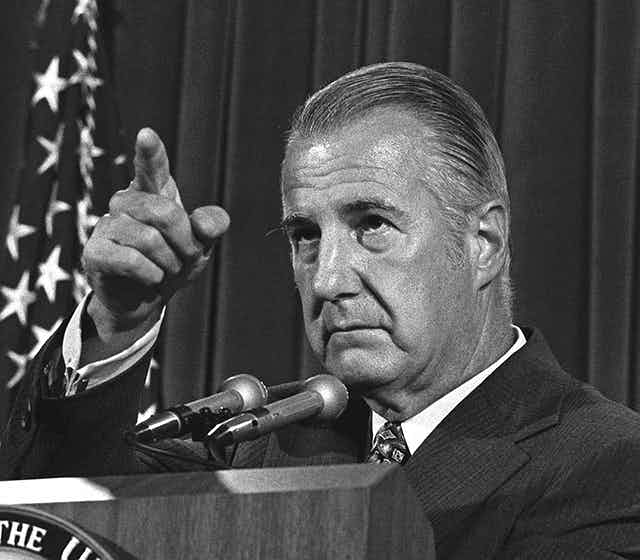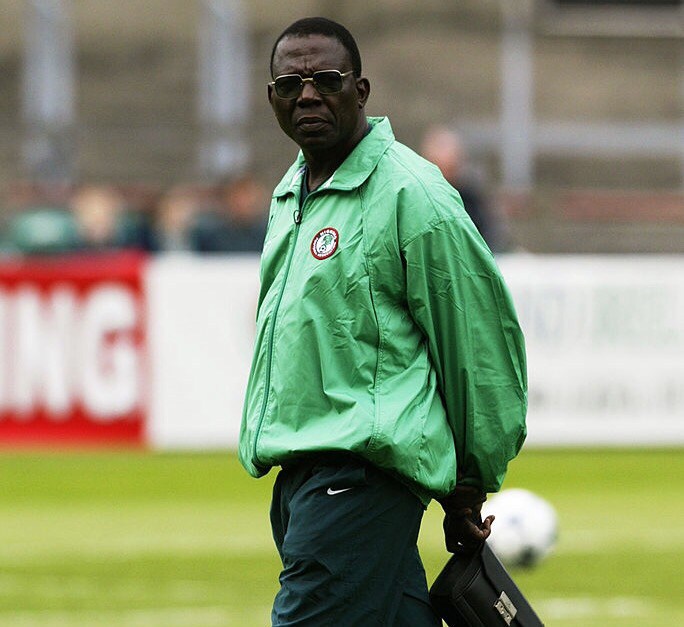
Spiro Agnew is best known for resigning as Richard Nixon’s vice president after pleading no contest to tax evasion and bribery charges.
But it was his instigation of a campaign that lasted more than four decades, portraying the mainstream media as biased, liberal, and aristocratic.
When Spiro Agnew targeted what were then the Big Three television networks for representing “a concentration of control over American public opinion unprecedented in history,” anti-media animosity had been boiling on the right for a long time.
In a speech in Des Moines in 1969, Spiro Agnew declared, “The American people would correctly not support this kind of concentration of power in government.”
“Isn’t it reasonable and appropriate to question its concentration in the hands of a small and closed fraternity of privileged men, chosen by no one and enjoying a government-sanctioned and licensed monopoly?”
Spiro Agnew was unflappable. He coined numerous memorable words with the help of skilled Nixon speechwriters (and, later, columnists) William Safire and Pat Buchanan, including the alliterative “nattering nabobs of negativism.”
Rarely has a well-coordinated political operation yielded such results. Reporters, editors, and producers have been looking over their right shoulders ever since, fearful of being accused of being secret carriers of the liberal virus.
However, the 2016 election prompted a ferocious progressive counter-offensive to the right-wing media’s cowardice. The media’s coverage of Donald Trump has sparked a new credibility problem.
There’s also the issue of Trump’s disproportionately large amount of broadcast time during the primaries, which eclipsed the attention paid to his rivals.
Liberals also believe that Trump is held to a lower standard than Hillary Clinton, which means that although each new Trump issue is given short shrift, the same old Clinton scandals are covered over and over again.
Allowing Trump to dominate television time throughout the primary campaign has little to do with the liberal-conservative debate, but the media will be held accountable.
Other Republican presidential contenders were harmed as a result of this, which demonstrated a desire for ratings that outweighed any concern for fairness.
However, the media’s treatment of Trump and Clinton suggests that a media that has long been sensitive to conservative criticism is now overcompensating against the other side.
One of the clearest descriptions of the problem came from Josh Marshall, the founder of the Talking Points Memo site.
“There’s no doubt,” he wrote last week, “that the investigation into the Clinton Foundation and Clinton’s emails has received a level of repetitious, hyper-skeptical, and saturation coverage that no investigative story about Donald Trump has come close to matching.” It’s not even close to being close.”
The issue isn’t that the media should be afraid to hold Clinton responsible. However, journalists should consider if they have built a narrative about Clinton that portrays her as less trustworthy than Trump, despite the overwhelming evidence that he lies far more than she does.
According to New York Times columnist Nicholas Kristof, PolitiFact found that although 53 percent of Trump’s claims were “False” or “Pants on Fire,” only 13% of Clinton’s were. Kristof remarked, “There is no parallel with Trump.”
Putting aside ideological issues, Marshall stated that “Trump’s repeated false assertions were so brazen and repetitious” that they “strained” all of the media’s established standards and practices. Trump continues to claim that he opposed the Iraq War, despite evidence to the contrary from 2002 and 2003.
And the birther in chief, who established a reputation for himself on the right by implying for years that Barack Obama was ineligible to be president, had the audacity to falsely claim Hillary Clinton was the one who started it all.
Even when Trump lies, journalists are often hesitant to brand him a liar, fearing that their objectivity would be called into question.
Liberals’ complaints about the media are frequently dismissed as biased, and the liberals are understandably enraged. They’re enraged that the right’s partisan media campaign has intimidated news organizations.
They’re enraged that Clinton’s flaws are exaggerated and harped on, whereas unfavorable stories about Trump are frequently reported once and then forgotten about. They’re even more enraged when Trump’s lies aren’t called lies.
However, the motivations of detractors should be irrelevant. What matters is whether or whether their allegations are valid. For the first time since Agnew launched the great conservative campaign against the media, those in charge of our news organizations are being systematically questioned about whether they are so afraid of right-wing condemnation that they have become demonstrably biased against the Democratic presidential candidate.
As a result, media criticism has – at long last – become fair and balanced.
[email protected] is E.J. Dionne’s email address.



![Watch Odegbami recreate his first goal in the 1980 AFCON final [Video] 7 Watch Odegbami recreate his first goal in the 1980 AFCON final [Video] 7](https://naijasuperfans.com/wp-content/uploads/2020/03/20200323_165745.png)
![How Nigeria won AFCON in 1980 – Segun Odegbami with Mumini Alao [Video] 8 How Nigeria won AFCON in 1980 – Segun Odegbami with Mumini Alao [Video] 8](https://naijasuperfans.com/wp-content/uploads/2020/03/20200321_201622.png)



